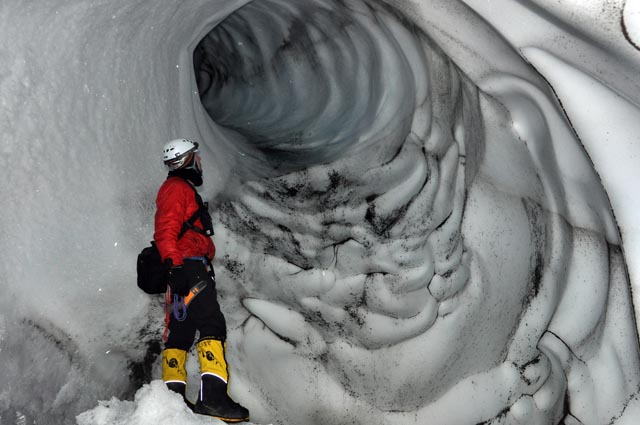|
Fungi erupt on ErebusDiscovery of fungal communities in ice caves highlights human contaminationPosted June 28, 2013
Researchers have identified more than 60 species of fungi from an ice cave near the top of Mount Erebus Laurie Connell It’s the first report of a fungal community being associated with what scientists call a dark oligotrophic volcanic ecosystem (DOVE) in Antarctica. DOVEs are nutrient-poor places in the Earth’s lithosphere, consisting of the crust and upper mantle, where life is able to subsist despite the absence of light for photosynthesis. 
Photo Credit: Hubert Staudigel
Photographer Alasdair Turner looks into a corkscrew hole in Wormtongue Hole ice cave.
“We don’t know how this deep biosphere works with the surface biosphere that we see all the time,” Staudigel said. “We suspect it’s important, but we know very little about it.” Staudigel is the principal investigator on a five-year field project in Antarctica to examine extreme environments like Mount Erebus to learn more about life in the early stages of Earth, when there would have been few if any sources of organic matter. Instead, microorganisms would have fed on rock minerals or perhaps the noxious gases of a hyper-volcanic young planet. [See previous article — It was a dark and cold ...: Scientists seek extremophiles in Antarctica's harshest environments.] The ice caves that dot the flanks of Mount Erebus are an ideal place to study such extremophiles. Gas and steam vent from the sides of Mount Erebus through fissures called fumaroles, sometimes carving out caves just below the ice-crusted surface. Warren Cave is located about 300 meters from the volcano’s rim near an established field camp called Lower Erebus Hut. Its easy accessibility for scientists and field parties — some visits perhaps dating back to the Heroic Age of Antarctic Exploration during the early 20th century — has made it one of the most visited and studied of the 120 known caves on the volcano. That has also made it more susceptible to human contamination. About a third of the 61 fungi species that Connell and her team identified represented Malassezia species, fungi that are associated with skin surfaces of animals and require high lipid content for growth. “I was surprised at [the high diversity] at first, but when I started looking at what we had, I realized we had a lot of things that were human associated,” said Connell, a co-principal investigator on the National Science Foundation Until recently, the decades-long research at Mount Erebus, led by Phil Kyle at New Mexico Institute of Mining and Technology But human contamination, from food scraps to dandruff, has the potential to upset these natural laboratories, Connell said, “because the communities are so tiny there, adding even a small amount of carbon and other nutrients is probably going to impact it significantly.” Last year, the United States presented a working paper at a meeting of the Antarctic Treaty In the interim, the National Science Foundation (NSF), which manages the U.S. Antarctic Program (USAP) |



For USAP Participants |
For The Public |
For Researchers and EducatorsContact UsNational Science FoundationOffice of Polar Programs Geosciences Directorate 2415 Eisenhower Avenue, Suite W7100 Alexandria, VA 22314 Sign up for the NSF Office of Polar Programs newsletter and events. Feedback Form |



